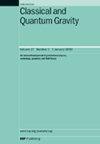Analytical model of Johnson–Kendall–Roberts adhesive contact with coating roughness on the release of test mass in TianQin
IF 3.7
3区 物理与天体物理
Q2 ASTRONOMY & ASTROPHYSICS
引用次数: 0
Abstract
The surface of the coating or substrate structure has a rough topological structure over multiple scales, which significantly affects the actual contact area and adhesion strength. In order to investigate potential interferences during the test mass (TM) release process of the locking and release mechanism in TianQin space-borne gravitational wave detection project, an analytical model of the Johnson–Kendall–Roberts (JKR) adhesive contact with coating roughness between the TM and the release tip has been developed. This work presents the integration of the JKR theory with the Greenwood–Williamson rough surface contact theory to address adhesion challenges and influence of roughness in space-borne gravitational wave detection systems. The comprehensive model can be used to analyze how various factors such as surface shape, material properties, coating thickness and roughness affect adhesion. By introducing a numerical approach based on the Newton down-hill method to solve coupled equations for gap, stress, and load balance, the model achieves high-precision predictions of adhesion behavior under multi-scale roughness effects. By establishing relationships between force, contact half-width, and penetration depth, it provides a theoretical basis for optimizing the TM release process and the design of the locking and release mechanism. Future work will validate predictions via high-precision torsion pendulum experiments.天琴试验质量释放过程中Johnson-Kendall-Roberts胶粘剂接触与涂层粗糙度的解析模型
涂层或衬底结构的表面在多个尺度上具有粗糙的拓扑结构,这显著影响实际接触面积和粘附强度。为了研究天琴星载引力波探测工程中锁定与释放机构测试质量释放过程中的潜在干扰,建立了基于TM与释放尖端之间涂层粗糙度的JKR (Johnson-Kendall-Roberts)粘接接触分析模型。这项工作提出了JKR理论与Greenwood-Williamson粗糙表面接触理论的集成,以解决空间重力波探测系统中附着挑战和粗糙度的影响。综合模型可用于分析表面形状、材料性能、涂层厚度和粗糙度等各种因素对附着力的影响。通过引入基于牛顿下坡法的数值方法来求解间隙、应力和负载平衡耦合方程,该模型实现了多尺度粗糙度作用下粘附行为的高精度预测。通过建立力、接触半宽度和侵彻深度之间的关系,为优化TM释放工艺和锁紧释放机构的设计提供理论依据。未来的工作将通过高精度扭摆实验验证预测。
本文章由计算机程序翻译,如有差异,请以英文原文为准。
求助全文
约1分钟内获得全文
求助全文
来源期刊

Classical and Quantum Gravity
物理-天文与天体物理
CiteScore
7.00
自引率
8.60%
发文量
301
审稿时长
2-4 weeks
期刊介绍:
Classical and Quantum Gravity is an established journal for physicists, mathematicians and cosmologists in the fields of gravitation and the theory of spacetime. The journal is now the acknowledged world leader in classical relativity and all areas of quantum gravity.
 求助内容:
求助内容: 应助结果提醒方式:
应助结果提醒方式:


